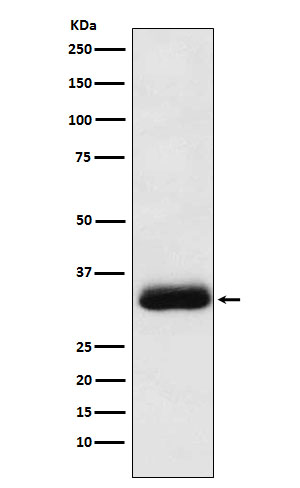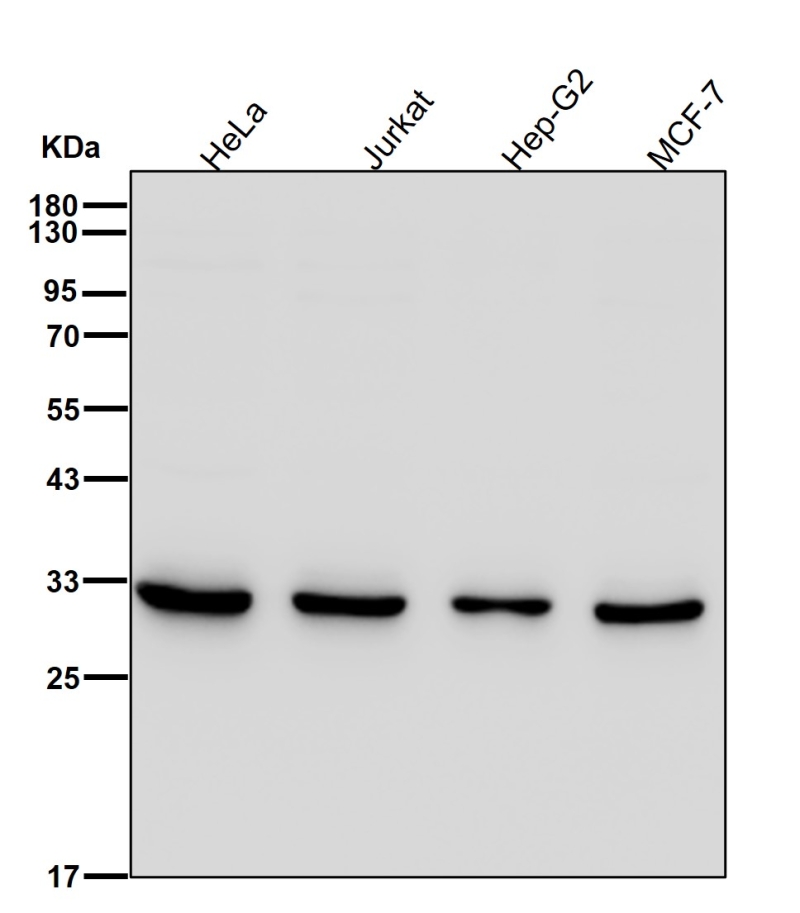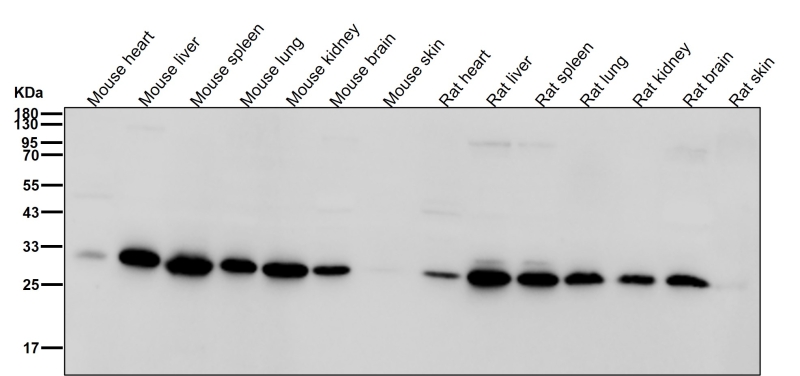


| WB | 1/1000-1/2000 | Human,Mouse,Rat |
| IF | 咨询技术 | Human,Mouse,Rat |
| IHC | 1/100-1/200 | Human,Mouse,Rat |
| ICC | 技术咨询 | Human,Mouse,Rat |
| FCM | 1/20-1/100 | Human,Mouse,Rat |
| Elisa | 咨询技术 | Human,Mouse,Rat |
| Aliases | H12.3; HLC-7; PIG21; RACK1; Gnb2-rs1;;RACK1 |
| WB Predicted band size | 35 kDa |
| Host/Isotype | Rabbit IgG |
| Antibody Type | Primary antibody |
| Storage | Store at 4°C short term. Aliquot and store at -20°C long term. Avoid freeze/thaw cycles. |
| Species Reactivity | Human,Mouse,Rat |
| Immunogen | A synthesized peptide derived from human RACK1 |
| Formulation | Purified antibody in PBS with 0.05% sodium azide,0.05% BSA and 50% glycerol. |
+ +
以下是关于RACK1抗体的3篇参考文献,涵盖其在不同研究中的应用:
---
1. **文献名称**:*RACK1 regulates neural development by interacting with Wnt signaling*
**作者**:Chen S, et al.
**摘要**:本研究利用RACK1特异性抗体,通过免疫共沉淀和Western blot技术,揭示了RACK1与Wnt信号通路组分(如β-catenin)的相互作用,表明其在神经发育中的调控作用,并发现RACK1缺失导致小鼠胚胎神经元分化异常。
---
2. **文献名称**:*RACK1 promotes pancreatic cancer progression by stabilizing EGFR signaling*
**作者**:Li Y, et al.
**摘要**:作者通过RACK1抗体进行免疫组化分析,发现RACK1在胰腺癌组织中高表达,并与EGFR形成复合物增强下游MAPK信号通路活性。抑制RACK1可减少肿瘤细胞侵袭,提示其作为癌症治疗靶点的潜力。
---
3. **文献名称**:*RACK1 mediates antiviral innate immunity by interacting with MAVS*
**作者**:Wang X, et al.
**摘要**:该研究通过RACK1抗体的免疫荧光和流式细胞术,证明RACK1与线粒体抗病毒信号蛋白(MAVS)结合,促进I型干扰素产生。敲低RACK1显著抑制病毒诱导的免疫反应,表明其在宿主抗病毒机制中的关键作用。
---
4. **文献名称**:*RACK1 modulates Alzheimer's disease pathology by regulating APP processing*
**作者**:Zhang L, et al.
**摘要**:利用RACK1抗体进行脑组织染色,发现RACK1与淀粉样前体蛋白(APP)结合,影响γ-分泌酶活性,减少Aβ生成。在阿尔茨海默病模型中,过表达RACK1可减轻认知障碍和神经元损伤。
---
以上文献展示了RACK1抗体在信号通路解析、癌症机制、免疫调控及神经疾病研究中的关键应用。
RACK1 (Receptor for Activated C Kinase 1) is a scaffolding protein belonging to the WD40 repeat family, playing a critical role in coordinating diverse cellular signaling pathways. It interacts with multiple kinases, including protein kinase C (PKC), Src, and integrins, regulating processes such as cell growth, migration, and stress responses. RACK1 is ubiquitously expressed and localized to the cytoplasm, nucleus, and plasma membrane, depending on cellular context. Its structure, characterized by seven WD40 repeats, facilitates protein-protein interactions, enabling it to act as a molecular hub.
Antibodies targeting RACK1 are widely used in research to study its expression, subcellular localization, and interactions in physiological and pathological conditions. These antibodies are essential tools in techniques like Western blotting, immunohistochemistry, co-immunoprecipitation, and fluorescence microscopy. Given RACK1's involvement in diseases such as cancer, neurodegenerative disorders, and viral infections, its antibodies help elucidate mechanisms of pathogenesis and therapeutic targeting. For example, dysregulated RACK1 expression correlates with tumor progression, metastasis, and drug resistance, making it a biomarker of interest.
Validation of RACK1 antibodies is critical, as cross-reactivity with other WD40 proteins may occur. Researchers often verify specificity using knockout cell lines or siRNA knockdown. Commercial RACK1 antibodies are typically raised against conserved regions, such as the N-terminal or central WD40 domains, ensuring broad species reactivity. Continued use of these antibodies advances understanding of RACK1's multifaceted roles in cellular signaling and disease.
×